【精选】反义疑问句练习题(附答案)
五年级英语反义疑问句练习题20题答案解析版

五年级英语反义疑问句练习题20题答案解析版1. You like apples, don't you?Yes, I do.No, I don't.答案解析:反义疑问句由两部分组成,前一部分是陈述句,后一部分是简短的疑问句。
前肯后否,前否后肯。
本句前半部分是肯定句“你喜欢苹果”,后半部分用否定形式“don't you”。
如果回答是“Yes, I do.”表示“是的,我喜欢。
”;如果回答是“No, I don't.”表示“不,我不喜欢。
”。
2. She goes to school by bus, doesn't she?Yes, she does.No, she doesn't.答案解析:前半部分“她乘公交车去上学”是肯定句,用一般现在时,第三人称单数形式,后半部分用否定形式“doesn't she”。
回答“Yes, she does.”表示“是的,她是。
”;回答“No, she doesn't.”表示“不,她不是。
”。
3. Your brother plays football, doesn't he?Yes, he does.No, he doesn't.答案解析:“你哥哥踢足球”是肯定陈述句,一般现在时,第三人称单数,反义疑问句用“doesn't he”。
回答“Yes, he does.”说明“是的,他踢足球。
”;回答“No, he doesn't.”说明“不,他不踢足球。
”。
4. We have English class on Monday, don't we?Yes, we do.No, we don't.答案解析:“我们周一有英语课”是肯定句,一般现在时,反义疑问句用“don't we”。
回答“Yes, we do.”表示“是的,我们有。
”;回答“No, we don't.”表示“不,我们没有。
(完整版)反义疑问句经典练习(含标准答案)
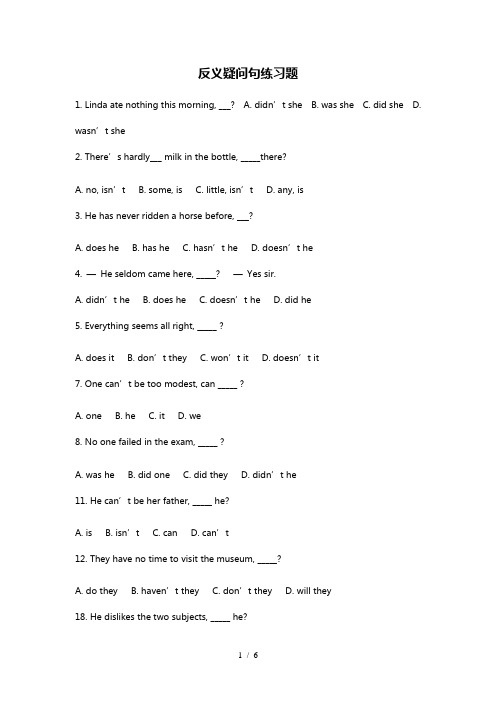
反义疑问句练习题1. Linda ate nothing this morning, ___? A. didn’t she B. was she C. did she D. wasn’t she2. There’s hardly___ milk in the bottle, _____there?A. no, isn’tB. some, isC. little, isn’tD. any, is3. He has never ridden a horse before, ___?A. does heB. has heC. hasn’t heD. doesn’t he4. —He seldom came here, _____? —Yes sir.A. didn’t heB. does heC. doesn’t heD. did he5. Everything seems all right, _____ ?A. does itB. don’t theyC. won’t itD. doesn’t it7. One can’t be too modest, can _____ ?A. oneB. heC. itD. we8. No one failed in the exam, _____ ?A. was heB. did oneC. did theyD. didn’t he11. He can’t be her father, _____ he?A. isB. isn’tC. canD. can’t12. They have no time to visit the museum, _____?A. do theyB. haven’t theyC. don’t theyD. will they18. He dislikes the two subjects, _____ he?A. doesB. doesn’tC. isD. isn’t19. These tools are useless now, _____ ?A. are theyB. aren’t theyC. is itD. isn’t it23. Let’s go there by bus, ___?A. will youB. shall weC. don’t youD. will you24. Let us go to play football, ___?A. will youB. shall weC. do weD. are we25. Don’t forget to give Polly some food and change her water, ___?A. will youB. shall weC. won’t youD. do you26. —Let’s go shopping this afternoon, _____? —All right.A. will weB. shall weC. don’t weD. are we27. —Pass me the dictionary, _____? —Yes, with pleasure.A. would youB. will youC. won’t youD. wouldn’t you30. There is little water in the glass, ____?A. isn’t thereB. isn’t itC. is itD. is there32. There won’t be any concert this Saturday evening, _____ ?A. will there notB. will thereC. is thereD. won’t33. —I guess she taught herself Japanese, ______? —Yes.A. don’t IB. did sheC. do ID. didn’t she34. I don’t believe you are right, _____ ?A. are youB. do youC. won’t youD. do35. She doesn’t think that Tom sings best in the class, _____ ?A. does sheB. doesn’t sheC. does heD. doesn’t he37. I know you didn’t want to hurt me, _____ ?A. did youB. didn’t youC. do ID. don’t I38. If my father were here he would be very happy, _____ ?A. weren’t heB. were heC. wouldn’t heD. would he1.It’s very hot today, _______________ ?2. He can speak Chinese, _______________ ?3. Meimei studies in a middle school, _______________ ?4. He never gets up late , _______________ ?5. Don’t go out at night, _______________ ?6.He never loves cold weather , _______________ ?7. You finished the task yesterday, _______________ ?9.T om has been to Singapore , _______________ ?10.The story is little interesting, _______________ ?11.Everything starts to grow in spring, _______________ ?12.He can hardly finish his homework, _______________ ?13.I’m in Class 3,Grade 2, _______________ ?14.Let’s go shopping , _______________ ?15.She doesn’t like climbing hills , _______________ ?16.I don’t think it is cold today, _______________ ?17. You think he is a good flight attendant, _______________ ?18.Nobody knows where she lives, _______________ ?19.Few students can answer the question, _______________ ?20.Mike likes English, _______________ ?21.That was a wonderful night, _______________ ?22.Your sister helped him, _______________ ?23.T om is skating, _______________ ?24.You aren’t a teacher, _______________ ?25.They haven’t been to the Great Wall, _______________ ?26.You will join the soccer team, _______________ ?27.He likes neither apples nor pears, _______________ ?28.There are some good books for you, _______________ ?29.They have been there twice, _______________ ?30.Let’s do it now, _______________ ?31.You dislike this kind of gifts, _______________ ?32.Nothing is impossible, _______________ ?33.Everything is possible, _______________ ?34.He doesn’t go to school by bus, _______________ ?35.There is little milk left in the bottle, _______________ ?36.Let us clean the classroom by ourselves, _______________ ?37.He has studied here for about four years, _______________ ?38.You have never lost money before, _______________ ?39.Few of them hurt themselves in the accident last night, _______________ ?40.Peter could hardly see the words on the blackboard, _______________ ?41.She’s American, _______________ ?42.There will be a volleyball match in our school, _______________ ?43.Don’t smoke in the reading-room, _______________ ?44.I don’t think he is right, _______________ ?45.You must do your homework by yourself, _______________ ?46.You mustn’t touch the machine, _______________ ?47.He must be a worker, _______________ ?48.Someone looked for me yesterday, _______________ ?49.I’m a teacher, _______________ ?50.What a nice watch, _______________ ?51.I wish to use your ruler, _______________ ?52.I have to stay at home, _______________ ?53.You’d better wear warm clothes today, _______________ ?54.What he needs is his parents’love, _______________ ?55.You’d like a cup of tea, _______________ ?56.Don’t be late again, _______________ ?57.Their prices are really low, _______________ ?58.Reading is good for you to learn English, _______________ ?59.No one knows about it, _______________ ?60.I think you should study hard, _______________ ?Key: 1—5 CDBDD 6—10 BACDC 11—15 AABAB 16—20 CCBBA 21—25CDBAA 26—30 BBBAD 31—35 BBDAA 36—38 AAC附加答案:1 . isn’t it 2. can’t he 3.doesn’t she 4.does he 5.will you6. does he7.didn’t you8. isn’t9.hasn’t he 10.is it 11.doesn’t it 12.can he 13 .aren’t I 14.shall we 15.does she 16.is it 17.don’t you 18does it 19. can they 20.doesn’t he 21.wasn’t it 22.didn’t she 23.isn’t he 24.are you 25.have they 26.wont you 27.does he 28.aren’t there 29.haven’t they 30.shall we 31.don’t you 32.is it 33.isn’t it 34.does he 35.is there 36.will you 37.hasn’t he 38.have you 39.did they 40.could he 41.isn’t she 42.won’t there 43.will you 44.is he 45.mustn’t you 46.must you 47.isn’t he 48.didn’t they 49.aren’t I 50.isn’t it51.may I 52.don’t I 53.hadn’t you 54.isn’t it 55.wouldn’t you 56.will you 57.aren’t they 58.isn’t it 59.do they 60.shouldn’t you。
六年级英语反义疑问句练习题30题(带答案)

六年级英语反义疑问句练习题30题(带答案)1. You are a student, aren't you?答案:是的,这是一个反义疑问句。
陈述句部分是肯定句“ You are a student”,反义疑问句的结构是“前肯后否”,所以疑问部分用“aren't you”。
2. He likes reading books, doesn't he?答案:在这个句子中,陈述句“He likes reading books”是肯定句,对于一般现在时的句子,主语是第三人称单数,反义疑问句的疑问部分要借助助动词“does”,并且遵循“前肯后否”的原则,所以是“doesn't he”。
3. They went to the park yesterday, didn't they?答案:陈述句“They went to the park yesterday”是肯定句,时态是一般过去时,在构成反义疑问句时,要借助助动词“did”,按照“前肯后否”的规则,所以疑问部分是“didn't they”。
4. She can speak English well, can't she?答案:这里陈述句“She can speak English well”是肯定句,句中有情态动词“can”,反义疑问句的疑问部分就用“can't she”,这是根据“前肯后否”的原则。
5. There is a book on the desk, isn't there?答案:陈述句“There is a book on the desk”是肯定句,存在句的反义疑问句,遵循“前肯后否”,疑问部分是“isn't there”。
6. You don't like math, do you?答案:陈述句“You don't like math”是否定句,反义疑问句的结构是“前否后肯”,所以疑问部分是“do you”。
30题反义疑问句经典练习(含答案)

反义疑问句1. Linda ate nothing this morning, ___?A. didn’t sheB. was sheC. did sheD. wasn’t she2. There’s hardly___ milk in the bottle, _____there?A. no, isn’tB. some, isC. little, isn’tD. any, is3. He has never ridden a horse before, ___?A. does heB. has heC. hasn’t heD. doesn’t he4. — He seldom came here, _____?— Yes sir.A. didn’t heB. does heC. doesn’t heD. did he5. Everything seems all right, _____ ?A. does itB. don’t theyC. won’t itD. doesn’t it6. One can’t be too modest, can _____ ?A. oneB. heC. itD. we7. No one failed in the exam, _____ ?A. was heB. did oneC. did theyD. didn’t he8. Neither you nor I am an artist, _____ ?A. am IB. aren’t weC. are weD. amn’t I9. He can’t be her father, _____ he?A. isB. isn’tC. canD. can’t10. They have no time to visit the museum, _____?A. do theyB. haven’t theyC. don’t theyD. will they11. You’d better go at once, _____ you?A. hadn’tB. didC. didn’tD. don’t12. You’d rather work than play, _____ you?A. hadn’tB. wouldn’tC. didn’tD. mustn’t13. You dare not do that, _____ you?A. don’tB. doC. dareD. daren’t14. He dislikes the two subjects, _____ he?A. doesB. do esn’tC. isD. isn’t15. These tools are useless now, _____ ?A. are theyB. aren’t theyC. is itD. isn’t it16. He used to get up at 6:30, _____ he?A. didn’t heB. did heC. used heD. wouldn’t he17. Let’s go there by bus, ___?A. will youB. shall weC. don’t youD. will you18. Let us go to play football, ___?A. will youB. shall weC. do weD. are we19. Don’t forget to give Polly some food and change her water, ___?A. will youB. shall weC. won’t youD. do you20. — Pass me the dictionary, _____?— Yes, with pleasure.A. would youB. will youC. won’t youD. wouldn’t you21. There is little water in the glass, ____?A. isn’t thereB. isn’t itC. is itD. is there22. — I guess she taught herself Japanese, ______?— Yes.A. don’t IB. did sheC. do ID. didn’t she23. I don’t believe you are right, _____ ?A. are youB. do youC. won’t youD. do I24. I know you didn’t want to hurt me, _____ ?A. did youB. didn’t youC. do ID. don’t I25. If my father were here he would be very happy, _____ ?A. weren’t heB. were heC. wouldn’t heD. would he26. Tina is unhappy now, ____________?27. You must have been to the Great Wall, ____________?28. Learning how to repair motors takes a long time, _____________?29. They must have stayed at home last night,____________?30. You needn’t attend the meeting, ______________________?Key: 1—5 CDBDD 6—10 AC CAA 11—15 ABCBB 16—20A BAAB 21—25DDAAC 26—30 isn’t she haven’t you doesn’t it didn’t they need you。
(完整版)初中英语反义疑问句经典练习(含答案)(改)

反义疑问句练习题1.Lind.at.nothin.thi.morning.___.......A.didn’.sh. B.wa.sh. C.di.sh. D.wasn’.sh.2.There’.hardly__.mil.i.th.bottle._____there..A.no.isn’..B.some.i..C.little.isn’..D.any.i.3.H.ha.neve.ridde..hors.before.___..... A.doe.h..B.ha.h..C.hasn’.h..D.doesn’.h.4..H.seldo.cam.here._____...Ye.sir.. A.didn’.h..B.doe.h..C.doesn’.h..D.di.h.5.Everythin.seem.al.right.____........ A.doe.i..B.don’.the..C.won’.i..D.doesn’.i.7.On.can’.b.to.modest.ca.____....... A.on..B.h..C.i..D.w.8.N.on.faile.i.th.exam.____........ A.wa.h..B.di.on..C.di.the..D.didn’.h.11.H.can’.b.he.father.____.he........A.i..B.isn’..C.ca..D.can’.12.The.hav.n.tim.t.visi.th.museum._____..A.d.the..B.haven’.the..C.don’.the..D.wil.the.18.H.dislike.th.tw.subjects.____.he.....A.doe..B.doesn’..C.i..D.isn’.eles.now.____.......A.ar.the..B.aren’.the..C.i.i..D.isn’.i.23.Let’.g.ther.b.bus.___..........A.wil.yo..B.shal.w..C.don’.yo..D.wil.yo.24.Le.u.g.t.pla.football.___........ A.wil.yo..B.shal.w..C.d.w..D.ar.w.25.Don’.forge.t.giv.Poll.som.foo.an.chang.he.water._.A.wil.yo..B.shal.w..C.won’.yo..D.d.yo.26..Let’.g.shoppin.thi.afternoon._____.. .Al.right.A.wil.w..B.shal.w..C.don’.w..D.ar.w.27..Pas.m.th.dictionary._____...Yes.wit.pleasure.A.woul.yo..B.wil.yo..C.won’.yo..D.wouldn’.yo.30.Ther.i.littl.wate.i.th.glass.____.A.isn’.ther..B.isn’.i..C.i.i..D.i.ther.32.Ther.won’.b.an.concer.thi.Saturda.evening.____..A.wil.ther.no..B.wil.ther..C.i.ther..D.won’.33...gues.sh.taugh.hersel.Japanese.______.. .Yes. A.don’...B.di.sh..C.d...D.didn’.sh.34..don’.believ.yo.ar.right.____...........A.ar.yo..B.d.yo..C.won’.yo..D.d.35.Sh.doesn’.thin.tha.To.sing.bes.i.th.class.____..A.doe.sh..B.doesn’.sh..C.doe.h..D.doesn’.h.37..kno.yo.didn’.wan.t.hur.me.____........A.di.yo..B.didn’.yo..C.d...D.don’..38.I.m.fathe.wer.her.h.woul.b.ver.happy.____..A.weren’.h..B.wer.h..C.wouldn’.h..D.woul.h.1.It’.ver.ho.today, _______________ ........2. H.ca.spea.Chinese, _______________ ?3. Meime.studie.i..middl.school, _______________ .t., _______________ ?5.Don’t go ou.a.night, _______________ .......6.H.neve.love.col.weathe., _______________ ?7.Yo.finishe.th.tas.yesterday, _______________ ...9.To.ha.bee.t.Singapor., _______________ ?10.Th.story i.littl.interesting, _______________ ?11.Everythin.start.t.gro.i.spring, _______________ . 12.H.ca.hardl.finis.hi.homework, _______________ ?13.I’.i.Clas.3,Grad.2, _______________ ........14.Let’.g.shoppin., _______________ ?15.Sh.doesn’.lik.climbin.hill., _______________ .... 16..don’.thin.i.i.col.today, _______________ ?17.Yo.thin.h.i..goo.fligh.attendant,. _______________ .18.Nobod.know.wher.sh.lives, _______________ ?19.Fe.student.ca.answe.th.question, _______________ ..20.Mik.like.English. _______________ ?21.That was a wonderful night, _______________ ? 22.Your sister helped him, _______________ ?23.Tom is skating, _______________ ?24.You aren’t a teacher, _______________ ?25.They haven’t been to the Great Wall, _______________ ? 26.You will join the soccer team, _______________ ?27.He likes neither apples nor pears, _______________ ? 28.There are some good books for you, _______________ ?29.They have been there twice, _______________ ? 30.Let’s do it now, _______________ ?31.You dislike this kind of gifts, _______________ ? 32.Nothing is impossible, _______________ ?33.Everything is possible, _______________ ? 34.He doesn’t go to school by bus, _______________ ?35.There is little milk left in the bottle, _______________ ?36.Let us clean the classroom by ourselves, _______________ ?37.He has studied here for about four years, _______________ ?38.You have never lost money before, _______________ ?39.Few of them hurt themselves in the accident last night, _______________ ?40.Peter could hardly see the words on the blackboard, _______________ ?41.She’s American, _______________ ? 42.There will be a volleyball match in our school, _______________ ? 43.Don’t smoke in the reading-room, _______________ ? 44.I don’t think he is right, _______________ ?45.You must do your homework by yourself, _______________ ?46.You mustn’t touch the machine, _______________ ?47.He must be a worker, _______________ ? 48.Someone looked for me yesterday, _______________ ?49.I’m a teacher, _______________ ? 50.What a nice watch, _______________ ?51.I wish to use your ruler, _______________ ? 52.I have to stay at home, _______________ ?53.You’d better wear warm clothes today, _______________ ?54.What he needs is his parents’ love, _______________ ?55.You’d like a cup of tea, _______________ ? 56.Don’t be late again, _______________ ?57.Their prices are really low, _______________ ? 58.Reading is good for you to learn English, _______________ ? 59.No one knows about it, _______________ ? 60.I think you should study hard, _______________ ?Key: 1—5 CDBDD 6—10 BACDC 11—15 AABAB 16—20 CCBBA 21—25CDBAA 26—30 BBBAD 31—35 BBDAA 36—38 AAC附加答案:..isn’.it.. 2.can’.h.. 3.doesn’.she..4.doe.he... 5.wil.yo.6.does.he.7.didn’.you .8..isn’....9.hasn’.he...10.i.it11.doesn’t it 12.can he 13 .aren’t I 14.shall we 15.does she16.is it 17.don’t you18does it 19. can they 20.doesn’t he21.wasn’t it 22.didn’t she 23.isn’t he 24.are you 25.have they26.wont you 27.does he 28.aren’t there 29.haven’t they 30.shall we31.don’t you 32.is it 33.isn’t it 34.does he 35.is th ere36.will you 37.hasn’t he 38.have you 39.did they 40.could he41.isn’t she 42.won’t there 43.will you 44.is he 45.mustn’t you46.must you 47.isn’t he 48.didn’t they 49.aren’t I 50.isn’t it51.may I 52.don’t I 53.hadn’t you 54.isn’t it 55.wouldn’t you56.will you 57.aren’t they 58.isn’t it 59.do they 60.shouldn’t you。
四年级英语反义疑问句练习题30题(答案解析)

四年级英语反义疑问句练习题30题(答案解析)1. You are a student, aren't you?答案解析:这是一个be动词(are)引导的反义疑问句。
反义疑问句的构成规则是:前半句是肯定陈述句,后半句则用否定的简短问句。
前半句“You are a student”是肯定句,所以后半句用“aren't you”。
2. He is a good boy, isn't he?答案解析:此题为be动词(is)引导的反义疑问句。
根据规则,前句为肯定陈述,后句要用否定疑问形式。
这里前半句“He is a good boy”是肯定的,所以后面是“isn't he”。
3. She was at school yesterday, wasn't she?答案解析:这是be动词((was)引导的反义疑问句。
由于前半句“She was at school yesterday”是肯定句,反义疑问句的后半句就要用否定形式“wasn't she”,这是遵循前肯后否的原则。
4. They like apples, don't they?答案解析:这里是助动词((do)引导的反义疑问句。
因为前半句“They like apples”是一般现在时的肯定陈述句,且句中的动词“like”是实义动词,所以反义疑问句的后半句要用助动词do的否定形式“don't they”。
5. We have a new book, don't we?答案解析:这是助动词((do)引导的反义疑问句。
前半句“We have a new book”是一般现在时的肯定句,其中“have”在这里是实义动词,按照规则,后半句要用助动词do的否定形式“don't we”。
6. Tom can swim, can't he?答案解析:这是情态动词((can)引导的反义疑问句。
四年级英语反义疑问句练习题30题带答案

四年级英语反义疑问句练习题30题带答案1. He is a student, isn't he?答案:是。
解析:在这个反义疑问句中,前面的陈述部分“He is a student”是肯定句,根据反义疑问句的规则,肯定句后面的疑问部分要用否定形式,所以是“isn't he”。
这里be动词是is,疑问部分就将is变为否定形式isn't,然后加上主语he。
2. She is happy, isn't she?答案:是。
解析:陈述部分“She is happy”为肯定句,按照规则,反义疑问句的疑问部分要用否定形式。
be动词是is,否定形式为isn't,再加上主语she。
3. It is a cat, isn't it?答案:是。
解析:前面陈述部分“It is a cat”是肯定句,对于这种以be动词is构成的肯定句,反义疑问句的疑问部分为否定形式,即把is变为isn't,再加上主语it。
4. You are a good boy, aren't you?答案:是。
解析:陈述部分“You are a good boy”是肯定句,由于be动词是are,所以反义疑问句的疑问部分为否定形式aren't,再加上主语you。
5. They are at home, aren't they?答案:是。
解析:陈述部分“They are at home”是肯定句,be动词为are,根据反义疑问句的规则,疑问部分为否定形式aren't,再加上主语they。
6. He is my father, isn't he?答案:是。
解析:陈述部分“He is my father”为肯定句,be动词是is,反义疑问句的疑问部分为否定形式isn't,再加上主语he。
7. She is in the classroom, isn't she?答案:是。
反义疑问句(含答案)
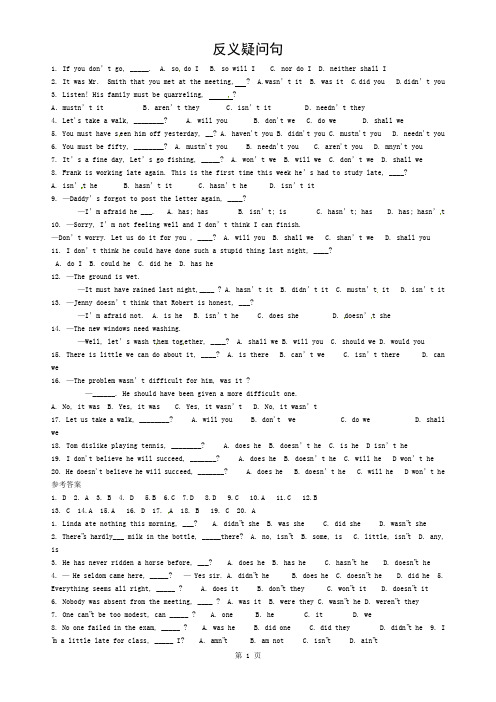
反义疑问句1. If you don’t go, _____. A. so do I B. so will I C. nor do I D. neither shall I2. It was Mr. Smith that you met at the meeting, ? A.wasn’t it B. was it C.did you D.didn’t you3. Listen! His family must be quarreling, ?A.mustn’t it B.aren’t they C.isn’t it D.needn’t they4. Let's take a walk, ________? A. will you B. don't we C. do we D. shall we5. You must have s een him off yesterday, __? A. haven't you B. didn't you C. mustn't you D. needn't you6. You must be fifty, ________? A. mustn't you B. needn't you C. aren't you D. mnyn't you7. It’s a fine day, Let’s go fishing, _____? A. won’t we B. will we C. don’t we D. shall we8. Frank is working late again. This is the first time this week he’s had t o study late, ____?A. isn’t heB. hasn’t itC. hasn’t heD. isn’t it9. —Daddy’s forgot to post the letter again, ____?—I’m afraid he ___. A. has; has B. isn’t; is C. hasn’t; has D. has; hasn’t 10. —Sorry, I’m not feeling well and I don’t think I can finish.—Don’t worry. Let us do it for you , ____? A. will you B. shall we C. shan’t we D. shall you11. I don’t think he could have done such a stupid thing last night, ____?A. do IB. could heC. did heD. has he12. —The ground is wet.—It must have rained last night,____ ? A. hasn’t it B. didn’t it C. mustn’t it D. isn’t it 13. —Jenny doesn’t think that Robert is honest, ___?—I’m afraid not. A. is he B. isn’t he C. does she D. doesn’t she14. —The new windows need washing.—Well, let’s wash t hem tog ether, ____? A. shall we B. will you C. should we D. would you15. There is little we can do about it, ____? A. is there B. can’t we C. isn’t there D. can we16. —The problem wasn’t difficult for him, was it ?—______. He should have been given a more difficult one.A. No, it wasB. Yes, it wasC. Yes, it wasn’tD. No, it wasn’t17. Let us take a walk, ________? A. will you B. don't we C. do we D. shall we18. Tom dislike playing tennis, ________? A. does he B. doesn’t he C. is he D isn’t he19. I don't believe he will succeed, _______? A. does he B. doesn’t he C. will he D won’t he20. He doesn't believe he will succeed, _______? A. does he B. doesn’t he C. will he D won’t he 参考答案1. D2. A3. B4. D5.B6.C7.D8.D9.C 10.A 11.C 12.B13. C 14.A 15.A 16. D 17. A 18. B 19. C 20. A1. Linda ate nothing this morning, ___? A. didn‟t she B. was she C. did she D. wasn‟t she2. There‟s hardly___ milk in the bottle, _____there? A. no, isn‟t B. some, is C. little, isn‟t D. any, is3. He has never ridden a horse before, ___? A. does he B. has he C. hasn‟t he D. doesn‟t he4. — He seldom came here, _____? — Yes sir. A. didn‟t he B. does he C. doesn‟t he D. did he5. Everything seems all right, _____ ? A. does it B. don‟t they C. won‟t it D. doesn‟t it6. Nobody was absent from the meeting, ____ ? A. was it B. were they C. wasn‟t he D. weren‟t they7. One can‟t be too modest, can _____ ? A. one B. he C. it D. we8. No one failed in the exam, _____ ? A. was he B. did one C. did they D. didn‟t he 9. I ‟m a little late for class, _____ I? A. amn‟t B. am not C. isn‟t D. ain‟t10. Neither you nor I am a artist, _____ ? A. am I B. aren‟t we C. are we D. ain‟t I11. He can‟t be her father, _____ he? A. is B. isn‟t C. can D. can‟t12. They have no time to visit the museum, __ ? A. do they B. haven‟t they C. don‟t they D. will they13. You have John do the work, _____? A. do you B. don‟t you C. haven‟t you D. have you14. You‟d better go at once, _____ you? A. hadn‟t B. did C. didn‟t D. don‟t 15. You ‟d rather work than play, _____ you? A. hadn‟t B. wouldn‟t C. didn‟t D. mustn‟t16. You dare not do that, _____ you? A. don‟t B. do C. dare D. daren‟t17. You must be tired, _____ you? A. mustn‟t B. needn‟t C. aren‟t D. can‟t18. He dislikes the two subjects, _____ he? A. does B. doesn‟t C. is D. isn‟t19. These tools are useless now, _____ ? A. are they B. aren‟t they C. is it D. isn‟t it20. He used to get up at 6:30, _____ he? A. didn‟t he B. did he C. used he D. wouldn‟t he21. I wish to go home early, _____ I? A. can B. must C. may D. do22. He ought to win the first prize, _______ he? A. mustn‟t B. oughtn‟t C. shouldn‟t D. Both B and C.23. Let‟s go there by bus, ___? A. will you B. shall we C. don‟t you D. will you24. Let us go to play football, ___? A. will you B. shall we C. do we D. are we25. Don‟t forget to give Polly some food and change her water,__?A. will youB.shall weC. won‟t youD. do you26. — Let‟s go shopping this afternoon, __? — All right. A. will we B. shall we C. don‟t we D. are we27. — Pass me the dictionary, ___ you? — Yes, with pleasure. A. would B. will C. won‟t D. wouldn‟t 28. — What beautiful weather, _____ ? — Yes, it is. A. is it B. isn‟t it C. am I right D. do you agree29. What kind people, _____ they? A. aren‟t B. are C. won‟t D. will30. There is little water in the glass, ____? A. isn‟t there B. isn‟t it C. is it D. is there31. — They don‟t seem to answer the phone. — There isn‟t anybody at home, _____?A. isn‟t thereB. is thereC. isn‟t itD. is it32. There won‟t be any concert this Saturday evening, ___ ?A. will there notB. will thereC. is thereD. won‟t33. — I guess she taught herself Japanese, ______? — Yes. A. don‟t I B. did she C. do I D. didn‟t she34. I don‟t believe you are right, _____ ? A. are you B. do you C. won‟t you D. do35. She doesn‟t think that Tom sings best in the class, __? A. does she B. doesn‟t she C. does he D. doesn‟t he 36. I told you that everybody couldn‟t do it well, _____ ? A. didn‟t I B. could they C. could he D. did I37. I know you didn‟t want to hurt me, _____ ? A. did you B. didn‟t you C. do I D. don‟t I38. If my father were here he would be very happy, __ ? A. weren‟t he B. were he C. wouldn‟t he D. would he 1—5 CDBDD 6—10 BACDC 11—15 AABAB 16—20 CCBBA 21—25CDBAA 26—30 BBBAD 31—35 BBDAA 36—38 AAC1. You’d rather watch TV this evening, ______?a. isn’t it b. hadn’t you c. wouldn’t you d. won’t you2. I suppose you’re not going today, ______? a. are you b. do you c. don’t you d. aren’t you3. I wish to shake hands with you, ______? a. shall b. may I c. do I d. will I4. Three hours ought to be enough time, ______?a. oughtn’t three hoursb. didn’t theyc. shouldn’t itd. shouldn’t three hours5. They have to study a lot, ______? a. don’t they b. haven’t they c. did they d. hadn’t they6. When the car crashed, your brother escaped being hurt, ______ ?a. didn’t heb. did hec. did itd. didn’t it7. I'm sure dirty, ______? a. am I b. isn’t I c. aren’t I d. am not I8. You seem to be dissatisfied with your present post. I don’t think you judged your ability objecti vely when you applied for it, ______ you? a. do b. did c. don’t d. didn’t9. That’s the sort of the book you want, ______? a. is it d. isn’t that c. is that d. isn’tit10. All these dictionaries are a great help to you, ______?a. are theyb. aren’t theyc. are all these dictionariesd. aren’t all these dictionaries11. The movie that we saw last week was quite interesting, ______?a. wasn’t itb. was itc. didn’t wed. weren’t we12. Tom has been writing letters all afternoon, but he should have finished them by now,______? a. hasn’t he b. has he c. shouldn’t he d. didn’t you13. David told me that you would take a trip to America, ______?a. would youb. woul dn’t youc. did youd. didn’t you14. There appeared to be no better way, ___? a. was there b. were therec. did thered. didn’t there15. You has some trouble finding where I live, ____? a. didn’t you b. hadn’t you c. doI d. don’t I16. He has his hair cut every month, ______? a. has he b. hasn’t he c. does he d. doesn’t he17. Your friend needs to come earlier, __? a. does he b. doesn’t he c. need he d. needn’t he18. The little boy dare not go to church, ___? a. dare he b. daren’t he c. does he d. doesn’t he19. Susan’d have worked abroad if she’d had the chance, ______?a. has sheb. hadn’t shec. would shed. wouldn’t she20. Everyone’s having a good time, ______? a. is he b. isn’t everyone c. does he d. aren’t they21. Any one can join the club, ______? a. can any one b. can’t any one c. can’t they d. can they22. Tell me how to operate the electronic computer, ___? a. will you b. shan’t you c. do you d. don’t you23. Magaret scarcely comes to visit you on Christmas Day, ______?a. doesn’t sheb. does shec. do youd. don’t you24. Let’s listen to the radio program that the teacher mentioned, ______?a. do web. don’t wec. shall wed. shan’t we25. You think you’re funny, ______? a. didn’t you b. are you c. don’t you d. do you26. Janet used to take part in labor in that village, ___? a. used she b. did she c. didn’t she d. should she27. What beautif ul weather, ______? a. is it b. isn’t it c. won’t it d. doesn’t it28. He ought to go to Kwangchow by plane, ______? a. should he b. shouldn’t he c. would he d. wouldn’t he29. We never dared to ask him a question, ______? a. did we b. didn’t we c. dared we d. daren’t we30. Nobody will believe how difficult his work has been ______?a. will heb. won’t nobodyc. will theyd. won’t they31. You must have made the mistake, __? a. mustn’t you b. haven’t you c. didn’t you d. hadn’t you32. Learning how to repair computers takes a long time, ______?a. isn’t itb. aren’t theyc. doesn’t itd. don’t they33. Jack has coffee with breakfast, ___? a. hasn’t Jack b. hasn’t he c. doesn’t Jack d. doesn’t he34. They must have stayed at hotel last night, ____?a. mustn’t theyb. haven’t theyc. didn’t theyd. hadn’t they35. There isn’t anything wrong with the radio, ______? a. is there b. is it c. does it d. does there36. You must be hungry, ______? a. must you b. mustn’t you c. are you d. aren’t you37. Let’s do the exercises by ourselves, ______? a. shall we b. shan’t we c. will you d. will we38. Her daughter had the carpets and curtains cleaned, ______?a. had sh eb. hadn’t shec. didn’t shed. didn’t her daughter39. The teacher had a talk with you, ______? a. has you b. hadn’t she c. did she d. didn’t she40. Something’ll have to be done about the air pollution, ______?a. won’t itb. will itc. has itd. does it1 C 19 D 37 A2 A 20 D 38 C3 B 21 C 39 D4 C 22 A 40 A5 A 23 B 41 6A 24 C 42 7 C 25 D 43 8B 26C 44 9D 27 B 45。
五年级英语反义疑问句练习题20题含答案解析
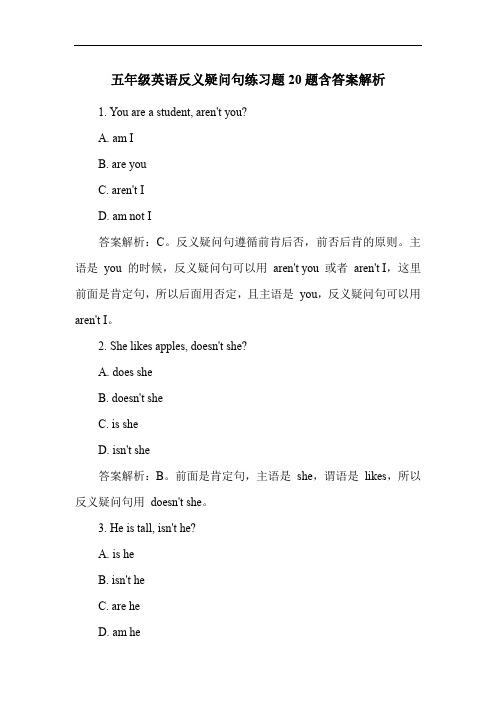
五年级英语反义疑问句练习题20题含答案解析1. You are a student, aren't you?A. am IB. are youC. aren't ID. am not I答案解析:C。
反义疑问句遵循前肯后否,前否后肯的原则。
主语是you 的时候,反义疑问句可以用aren't you 或者aren't I,这里前面是肯定句,所以后面用否定,且主语是you,反义疑问句可以用aren't I。
2. She likes apples, doesn't she?A. does sheB. doesn't sheC. is sheD. isn't she答案解析:B。
前面是肯定句,主语是she,谓语是likes,所以反义疑问句用doesn't she。
3. He is tall, isn't he?A. is heB. isn't heC. are heD. am he答案解析:B。
前肯后否,主语是he,be 动词是is,所以反义疑问句用isn't he。
4. They are happy, aren't they?A. are theyB. aren't theyC. is theyD. am they答案解析:B。
前肯后否,主语是they,be 动词是are,所以反义疑问句用aren't they。
5. I am a teacher, aren't I?A. am IB. are youC. aren't ID. am not I答案解析:C。
前肯后否,主语是I,反义疑问句可以用aren't I 或者am I not。
6. She has a book, doesn't she?A. does sheB. doesn't sheC. has sheD. hasn't she答案解析:B。
初二英语反意疑问句练习题30题(带答案)

初二英语反意疑问句练习题30题(带答案)1. You are a student, aren't you?答案解析:在反意疑问句中,前半句是肯定句,主语是you,谓语是be动词are,后半句则用否定形式aren't you。
规则是前肯后否,主语不变,be动词与前半句一致。
2. He is from China, isn't he?答案解析:前半句为肯定句,主语是he,be动词是is,所以后半句是isn't he。
反意疑问句的结构是前句肯定,后句否定,这里be动词根据前半句保持一致,主语也保持一致。
3. She likes reading books, doesn't she?答案解析:前半句是肯定句,主语是she,实义动词是likes(一般现在时第三人称单数形式),后半句要用助动词does的否定形式doesn't,再加上主语she。
因为在一般现在时中,主语是第三人称单数的实义动词句子,在构成反意疑问句时要用助动词does。
4. They play football every day, don't they?答案解析:前句是肯定句,主语是they,实义动词是play,一般现在时,在构成反意疑问句时,后半句要用助动词do的否定形式don't,再加上主语they。
5. We are going to have a party, aren't we?答案解析:前句肯定,主语是we,be动词是are,后半句就用aren't we。
这里遵循前肯后否的规则,be动词和主语与前句保持一致。
6. It is a lovely dog, isn't it?答案解析:前句肯定,主语是it,be动词是is,后半句为isn't it。
反意疑问句的规则是前句肯定,后句否定,be动词和主语保持不变。
7. Tom has a new bike, doesn't he?答案解析:前句肯定,主语是Tom( 第三人称单数),has在这里是实义动词“有”的意思,在一般现在时中,这种情况下后半句要用助动词does的否定形式doesn't,再加上主语he。
初二英语反意疑问句练习题50题含答案解析

初二英语反意疑问句练习题50题含答案解析1. You are a student, aren't you?答案解析:这是一个典型的反意疑问句。
前半句是肯定句,结构为主语+be动词(are)+表语(a student),后半句则是由be动词(aren't)+主语 you)构成的疑问部分。
根据反意疑问句的规则,前肯后否,所以这里用aren't you。
2. He was at home yesterday, wasn't he?答案解析:前半句是肯定句,结构为主语(He)+be动词(was)+地点状语 at home)+时间状语 yesterday)。
反意疑问句的后半句由be动词 wasn't)+主语 he)组成,遵循前肯后否的原则。
3. They like English, don't they?答案解析:前半句是肯定句,主语 They)+实义动词 like)+宾语(English)。
在反意疑问句中,因为前半句没有be动词,这里的实义动词是like,主语是they,所以后半句要用助动词do的否定形式don't,再加上主语they。
4. She has a book, doesn't she?答案解析:前半句为肯定句,主语(She)+谓语(has,这里has 表示拥有,是实义动词)+宾语(a book)。
反意疑问句后半句要借助助动词do,因为主语是she,所以是doesn't she,遵循前肯后否。
5. It is a fine day today, isn't it?答案解析:前半句是肯定句,结构为主语 It)+be动词 is)+表语 a fine day)+时间状语 today)。
反意疑问句后半句为be动词isn't)+主语 it),按照前肯后否的原则。
6. You can swim, can't you?答案解析:前半句是肯定句,主语(You)+情态动词(can)+动词原形(swim)。
(完整版)反义疑问句练习题(附答案)
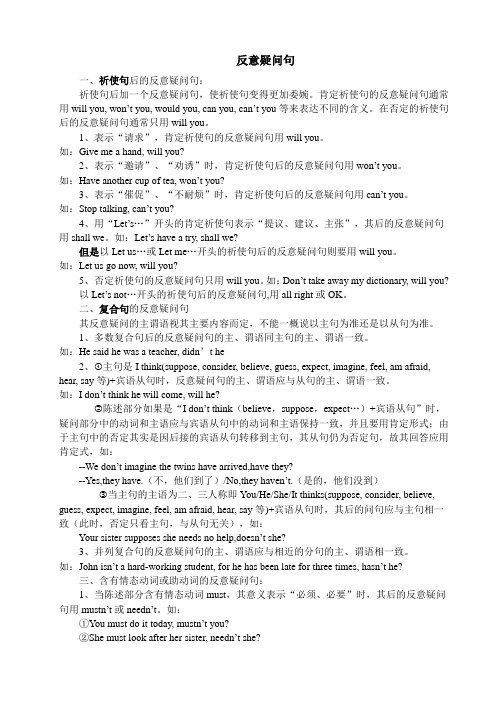
反意疑问句一、祈使句后的反意疑问句:祈使句后加一个反意疑问句,使祈使句变得更加委婉。
肯定祈使句的反意疑问句通常用will you, won’t you, would you, can you, can’t you等来表达不同的含义。
在否定的祈使句后的反意疑问句通常只用will you。
1、表示“请求”,肯定祈使句的反意疑问句用will you。
如:Give me a hand, will you?2、表示“邀请”、“劝诱”时,肯定祈使句后的反意疑问句用won’t you。
如:Have another cup of tea, won’t you?3、表示“催促”、“不耐烦”时,肯定祈使句后的反意疑问句用can’t you。
如:Stop talking, can’t you?4、用“Let’s…”开头的肯定祈使句表示“提议、建议、主张”,其后的反意疑问句用shall we。
如:Let’s have a try, shall we?但是以Let us…或Let me…开头的祈使句后的反意疑问句则要用will you。
如:Let us go now, will you?5、否定祈使句的反意疑问句只用will you。
如:Don’t take away my dictionary, will you?以Let’s not…开头的祈使句后的反意疑问句,用all right或OK。
二、复合句的反意疑问句其反意疑问的主谓语视其主要内容而定,不能一概说以主句为准还是以从句为准。
1、多数复合句后的反意疑问句的主、谓语同主句的主、谓语一致。
如:He said he was a teacher, didn’t he2、①主句是I think(suppose, consider, believe, guess, expect, imagine, feel, am afraid, hear, say等)+宾语从句时,反意疑问句的主、谓语应与从句的主、谓语一致。
五年级英语反义疑问句练习题20题(带答案)

五年级英语反义疑问句练习题20题(带答案)1. He is a good student, isn't he?答案:是的,他是。
因为前面是肯定句,反义疑问句部分为否定形式。
这里遵循“前肯后否”的原则,回答时如果事实是肯定的,就用Yes,he is。
2. She can sing well, can't she?答案:是的,她能。
前面是肯定句,反义疑问句部分为否定形式。
按照规则,若实际情况是肯定的,就回答Yes, she can。
3. They like playing football, don't they?答案:是的,他们喜欢。
这是肯定陈述句,反义疑问句部分为否定。
当实际情况是肯定时,回答为Yes, they do。
4. It was a beautiful day yesterday, wasn't it?答案:是的,昨天是。
前面为肯定句,反义疑问句为否定形式。
若事实是肯定的,回答是Yes, it was。
5. You have a sister, don't you?答案:是的,我有。
对于这种肯定陈述句后的反义疑问句,当实际情况为肯定时,回答为Yes, I do。
6. He doesn't like apples, does he?答案:是的,他不喜欢。
前面是否定句,反义疑问句部分为肯定形式。
如果实际情况是否定的,就回答Yes, he doesn't。
7. She isn't at home now, is she?答案:是的,她不在。
由于前面是否定句,反义疑问句为肯定形式。
当事实是否定时,回答为Yes, she isn't。
8. They didn't go to school yesterday, did they?答案:是的,他们没去。
前面是否定句,反义疑问句为肯定形式。
若实际情况是否定的,回答是Yes, they didn't。
四年级英语反义疑问句练习题30题(答案解析)

四年级英语反义疑问句练习题30题(答案解析)1. You are a student, aren't you?A. am IB. are youC. aren't ID. am not I答案解析:本题考查反义疑问句的构成规则。
反义疑问句由两部分组成,前一部分是陈述句,后一部分是简短的疑问句,且前后两部分的人称和时态要一致。
在本题中,前一部分是“You are a student”,后一部分应该是“aren't you”。
选项A“am I”人称不一致;选项B“are you”与前一部分重复;选项C“aren't I”在口语中可以使用,但在正式场合中一般用“aren't you”;选项D“am not I”比较正式,但不常用。
所以正确答案是aren't you。
2. She likes apples, doesn't she?A. does sheB. doesn't sheC. is sheD. isn't she答案解析:本题中,前一部分是“She likes apples”,后一部分应该是“doesn't she”。
选项A“does she”与前一部分重复;选项C“is she”时态和动词不一致;选项D“isn't she”动词不一致。
所以正确答案是doesn't she。
3. He is tall, isn't he?A. is heB. isn't heC. are heD. am he答案解析:前一部分是“He is tall”,后一部分应为“isn't he”。
选项A“is he”与前一部分重复;选项C“are he”人称和动词不一致;选项D“am he”人称和动词不一致。
正确答案是isn't he。
4. They play football, don't they?A. do theyB. don't theyC. are theyD. aren't they答案解析:前一部分是“They play football”,后一部分是“don't they”。
六年级英语反意疑问句练习题40题含答案解析
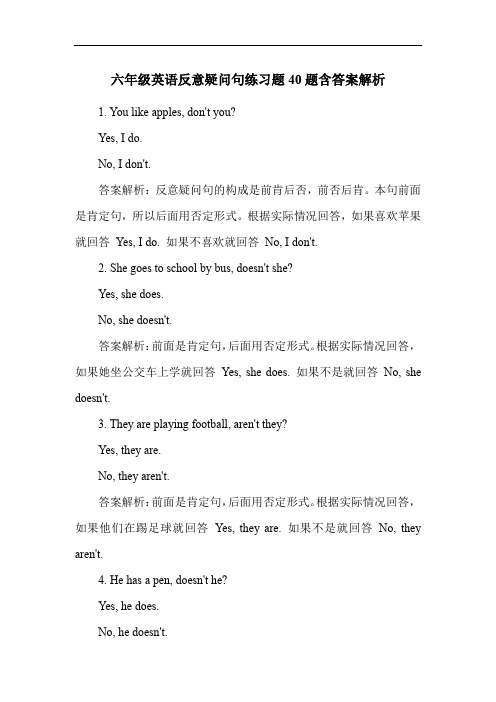
六年级英语反意疑问句练习题40题含答案解析1. You like apples, don't you?Yes, I do.No, I don't.答案解析:反意疑问句的构成是前肯后否,前否后肯。
本句前面是肯定句,所以后面用否定形式。
根据实际情况回答,如果喜欢苹果就回答Yes, I do. 如果不喜欢就回答No, I don't.2. She goes to school by bus, doesn't she?Yes, she does.No, she doesn't.答案解析:前面是肯定句,后面用否定形式。
根据实际情况回答,如果她坐公交车上学就回答Yes, she does. 如果不是就回答No, she doesn't.3. They are playing football, aren't they?Yes, they are.No, they aren't.答案解析:前面是肯定句,后面用否定形式。
根据实际情况回答,如果他们在踢足球就回答Yes, they are. 如果不是就回答No, they aren't.4. He has a pen, doesn't he?Yes, he does.No, he doesn't.答案解析:前面是肯定句,后面用否定形式。
根据实际情况回答,如果他有一支笔就回答Yes, he does. 如果没有就回答No, he doesn't.5. We are happy, aren't we?Yes, we are.No, we aren't.答案解析:前面是肯定句,后面用否定形式。
根据实际情况回答,如果我们开心就回答Yes, we are. 如果不开心就回答No, we aren't.6. You don't like oranges, do you?Yes, I do.No, I don't.答案解析:前面是否定句,后面用肯定形式。
(完整版)反义疑问句练习(带答案)

初三反义疑问句1.It’s very hot today,_________________________?2.He can speak Chinese,_________________________?3.Mary studies in a junior high school,_________________________?4.He never gets up late,_________________________?5.Don’t go out at night,_________________________?6.He seldom loves cold weather,_________________________?7.You finished the task yesterday,_________________________?8.Tom has been to Singapore,_________________________?9.The story is a little interesting,_________________________?10.E verything starts to grow in spring,_________________________?11.H e can hardly finish his homework,_________________________?12.I’m in Class 3,Grade 2,_________________________?13.L et’s go shopping,_________________________?14.S he doesn’t like climbing hills,_________________________?15.N obody knows where she lives,_________________________?16.F ew students can answer the question,_________________________?17.T hat was a wonderful night,_________________________?18.Y our sister helped me,_________________________?19.Y ou aren’t a teacher,_________________________?20.T hey haven’t been to the Great Wall,_________________________?21.Y ou will join the soccer team,_________________________?22.H e likes neither apples nor pears,_________________________?23.T here are some good books for you,_________________________?24.L et’s do it now,_________________________?25.Y ou dislike this kind of gifts,_________________________?26.N othing is impossible,_________________________?27.E verything is possible,_________________________?28.H e doesn’t go to school by bus,_________________________?29.T here is little milk lsft in the bottle,_________________________?30.L et us clean the classroom by ourselves,_________________________?31.H e has studied here for about four years,_________________________?32.Y ou never lost money before,_________________________?33.F ew of them hurt themselves in the accident last night,_________________________?34.P eter could hardly see the words on the blackboard,_________________________?35.T here will be a volleyball match in our school,_________________________?36.D on’t smoke in the reading room,_________________________?37.I don’t think he is right,_________________________?38.Y ou must do your homework by yourself,_________________________?39.Y ou mustn’t touch the machine,_________________________?40.S omeone looked for you yesterday,_________________________?1.isn’t it2.can’t he3.doesn’t she4.does he5.will you6.does he7.didn’t you8.hasn’t he9.isn’t it 10.doesn’t it 11.c an he 12.aren’t I 13.shall we 14.does she 15.do they/does he16.c an they 17.wasn’t it 18.didn’t she 19.are you 20.have they21.w on’t you 22.does he 23.aren’t there 24.shall we 25.don’t you 26.i s it 27.isn’t it 28.does he 29.is there 30.will you 31.hasn’t he 32.d id you 33.did they 34. could he 35.won’t there 36.will you37.is he 38.mustn’t you 39.must you 40.didn’t they/didn’t he。
完整版)反义疑问句经典练习(含答案)

完整版)反义疑问句经典练习(含答案)1.XXX't eat anything this morning。
did she?2.There'XXX。
is there?3.He has never ridden a horse before。
has he?4.He seldom came here。
did he?5.Everything seems all right。
doesn't it?7.One can't be too modest。
can one?8.No one failed in the exam。
did they?11.He can't be her father。
can he?12.They have no time to visit the museum。
do they?18.He dislikes the two subjects。
doesn't he?19.These tools are useless now。
XXX?23.Let's go there by bus。
shall we?A。
XXX24.Shall we go play football?25.Won't you give Polly some food and change her water?26.Shall we go shopping this afternoon?27.Would you pass me the nary。
please?30.Is there little water in the glass?32.XXX Saturday evening?33.Did XXX?34.Don't you believe you are right?35.Doesn't she think that Tom sings best in the class? XXX't want to hurt me。
四年级英语反义疑问句练习题30题含答案解析

四年级英语反义疑问句练习题30题含答案解析1.She is a student, isn't she?Yes, she is. 本题考查be 动词的反义疑问句。
前半句是肯定句,be 动词是is,所以后半句用isn't she。
2.They are in the classroom, aren't they?Yes, they are. 前半句是肯定句,be 动词是are,反义疑问句用aren't they。
3.He is a teacher, isn't he?Yes, he is. 肯定句中be 动词是is,反义疑问句用isn't he。
4.We are friends, aren't we?Yes, we are. 肯定句be 动词是are,反义疑问句用aren't we。
5.The book is on the desk, isn't it?Yes, it is. 肯定句be 动词是is,反义疑问句用isn't it。
6.She is happy, isn't she?Yes, she is. 肯定句be 动词是is,反义疑问句用isn't she。
7.They are playing games, aren't they?Yes, they are. 肯定句be 动词是are,反义疑问句用aren't they。
8.He is reading a book, isn't he?Yes, he is. 肯定句be 动词是is,反义疑问句用isn't he。
9.We are having lunch, aren't we?Yes, we are. 肯定句be 动词是are,反义疑问句用aren't we。
10.The girl is singing, isn't she?Yes, she is. 肯定句be 动词是is,反义疑问句用isn't she。
四年级英语反意疑问句练习题40题(带答案)
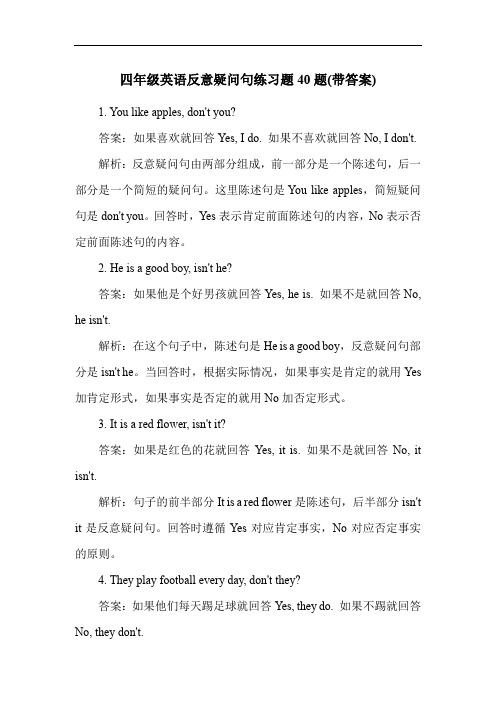
四年级英语反意疑问句练习题40题(带答案)1. You like apples, don't you?答案:如果喜欢就回答Yes, I do. 如果不喜欢就回答No, I don't.解析:反意疑问句由两部分组成,前一部分是一个陈述句,后一部分是一个简短的疑问句。
这里陈述句是You like apples,简短疑问句是don't you。
回答时,Yes表示肯定前面陈述句的内容,No表示否定前面陈述句的内容。
2. He is a good boy, isn't he?答案:如果他是个好男孩就回答Yes, he is. 如果不是就回答No, he isn't.解析:在这个句子中,陈述句是He is a good boy,反意疑问句部分是isn't he。
当回答时,根据实际情况,如果事实是肯定的就用Yes 加肯定形式,如果事实是否定的就用No加否定形式。
3. It is a red flower, isn't it?答案:如果是红色的花就回答Yes, it is. 如果不是就回答No, it isn't.解析:句子的前半部分It is a red flower是陈述句,后半部分isn't it是反意疑问句。
回答时遵循Yes对应肯定事实,No对应否定事实的原则。
4. They play football every day, don't they?答案:如果他们每天踢足球就回答Yes, they do. 如果不踢就回答No, they don't.解析:陈述句They play football every day,反意疑问句部分是don't they。
回答这种反意疑问句时,根据实际情况,用Yes或No加上相应的助动词形式。
5. She has a cat, doesn't she?答案:如果她有猫就回答Yes, she does. 如果没有就回答No, she doesn't.解析:这里陈述句是She has a cat,因为has在这里是实义动词,所以反意疑问句部分是doesn't she。
- 1、下载文档前请自行甄别文档内容的完整性,平台不提供额外的编辑、内容补充、找答案等附加服务。
- 2、"仅部分预览"的文档,不可在线预览部分如存在完整性等问题,可反馈申请退款(可完整预览的文档不适用该条件!)。
- 3、如文档侵犯您的权益,请联系客服反馈,我们会尽快为您处理(人工客服工作时间:9:00-18:30)。
反意疑问句一、祈使句后的反意疑问句:祈使句后加一个反意疑问句,使祈使句变得更加委婉。
肯定祈使句的反意疑问句通常用will you, won’t you, would you, can you, can’t you等来表达不同的含义。
在否定的祈使句后的反意疑问句通常只用will you。
1、表示“请求”,肯定祈使句的反意疑问句用will you。
如:Give me a hand, will you?2、表示“邀请”、“劝诱”时,肯定祈使句后的反意疑问句用won’t you。
如:Have another cup of tea, won’t you?3、表示“催促”、“不耐烦”时,肯定祈使句后的反意疑问句用can’t you。
如:Stop talking, can’t you?4、用“Let’s…”开头的肯定祈使句表示“提议、建议、主张”,其后的反意疑问句用shall we。
如:Let’s have a try, shall we?但是以Let us…或Let me…开头的祈使句后的反意疑问句则要用will you。
如:Let us go now, will you?5、否定祈使句的反意疑问句只用will you。
如:Don’t take away my dictionary, will you?以Let’s not…开头的祈使句后的反意疑问句,用all right或OK。
二、复合句的反意疑问句其反意疑问的主谓语视其主要内容而定,不能一概说以主句为准还是以从句为准。
1、多数复合句后的反意疑问句的主、谓语同主句的主、谓语一致。
如:He said he was a teacher, didn’t he2、主句是I think(suppose, consider, believe, guess, expect, imagine, feel, am afraid, hear, say等)+宾语从句时,反意疑问句的主、谓语应与从句的主、谓语一致。
如:I don’t think he will come, will he?陈述部分如果是“I don’t think(believe,suppose,expect…)+宾语从句”时,疑问部分中的动词和主语应与宾语从句中的动词和主语保持一致,并且要用肯定形式;由于主句中的否定其实是因后接的宾语从句转移到主句,其从句仍为否定句,故其回答应用肯定式,如:--We don’t imagine the twins have arrived,have they?--Yes,they have.(不,他们到了)/No,they haven’t.(是的,他们没到)当主句的主语为二、三人称即You/He/She/It thinks(suppose, consider, believe, guess, expect, imagine, feel, am afraid, hear, say等)+宾语从句时,其后的问句应与主句相一致(此时,否定只看主句,与从句无关),如:Your sister supposes she needs no help,doesn’t she?3、并列复合句的反意疑问句的主、谓语应与相近的分句的主、谓语相一致。
如:John isn’t a hard-working student, for he has been late for three times, hasn’t he?三、含有情态动词或助动词的反意疑问句:1、当陈述部分含有情态动词must,其意义表示“必须、必要”时,其后的反意疑问句用mustn’t或needn’t。
如:①You must do it today, mustn’t you?②She must look after her sister, needn’t she?如果must的含义表示“一定是、想必”等推测意义时,其后的反意疑问句则要依据句中的谓语动词的时态结构采用be/have/did/do+not等相应形式。
如:①He must bee ill, isn’t he?②You must have seen the film before, haven’t you?2、如果陈述部分用了must have+P.P.(过去分词),但明示或暗示了过去的时间,其反意疑问句用过去时。
如:He must have seen him yesterday, didn’t he?3、陈述部分含情态动词ought to,其后反意疑问句用oughtn’t或shouldn’t.如:I ought to come here, oughtn’t I?4、陈述部分含情态动词used to其后反意疑问句用usedn’t或didn’t均可。
如:Tom used to live here, usedn’t he?5、陈述部分含有have/has/had to时,其后的反意疑问句用do的相应形式。
如:You have to go, don’t you?但是在陈述句中用have/has/had got to来代替have/has/had to时,反意疑问句用have 的相应形式。
如:Ann has got to see a doctor, hasn’t she?6、陈述部分有had better/would rather时,其后的反意疑问句用hadn’t/wouldn’t。
如:①You’d better not stay here, had you?②They would rather take this one, wouldn’t they?7、当陈述部分有dare或need时,若dare和need为实义动词疑问部分的谓语用do的适当形式;若dare和need为情态动词,疑问部分用dare和need构成。
Need与Dare 用法区别一、need的用法1)need可用作实义动词,意为"需要;必要",后面可接名词、动名词或动词不定式等作宾语。
注意"need doing"表示被动意义,相当于need to be done。
例如:I need a dictionary, so I need to go to the bookstore. 我需要一本词典,因此我要去趟书店。
How often does your hair need washing(need to be washed)? 你的头发需要多久洗一次?2)need可用作情态动词,通常用于疑问句和否定句中,后接动词原形。
这时need没有人称和数的变化,也没有时态的变化。
例如:It's only eight o'clock. Need you go so early? 才八点。
你需要去这么早吗?You needn't tell him about it as I have told him. 你不必跟他说那件事,我已经告诉他了。
3)needn't do与needn't have done的区别:两者都表示"不必做......"。
但前者表示现在或将来不必做;而后者表示"过去(本来)不必做(而事实上已经做了)"。
例如:You needn't carry the desks out of the classroom when you clean the classroom. 你打扫教室时不必把桌子搬到教室外。
You needn't have bought such a big TV as it takes too much room. 你本来不必买这么大的电视,它占据的空间太大了(而事实上已经买了)。
二、dare的用法1)dare用作实义动词,此时其后的动词不定式可带to也可不带to,且dare有人称和数以及时态的变化。
例如:I dare to jump down from the top of the wall. 我敢从那墙头上跳下来。
She doesn't dare (to) meet her teacher's eyes. 她不敢与老师对视。
2)dare用作情态动词,后跟动词原形,主要用于疑问句、否定句和条件句中。
例如:How dare she do things like that to me? 她怎么敢对我做那种事?-Dare you catch the mouse? 你敢去抓那只老鼠吗?-I daren't do that. 我不敢抓。
If you dare say that to our teacher, I would vote for you. 如果你敢向我们的老师说那件事,我就投你一票。
四、陈述句主语是某些不定代词的反意疑问句:1、陈述句部分主语是everything, something, anything, nothing时,其后的反意疑问句主语用it。
如:①Everything seems all right, doesn’t it?②Nothing is in the box, is it?2、陈述部分的主语是everybody, somebody, anybody, nobody, everyone, no one, none, either, some one时,其后的反意疑问句用主语they以兼顾所指代的男、女两性。
如:Everybody has got the new books, haven’t they?3、陈述部分主语是不定代词one时,其后的反意疑问句一般用主语one。
如:One can’t be always careful, can one?五、含有否定词或半否定词的反意疑问句:1、陈述部分含有no, never, seldom, hardly, rarely, scarely, few, little等否定或半否定意义的词时,都视为否定,故反意疑问句部分用肯定形式。
如:Few people knew the answer, did they?2、如果陈述部分的否定意义只是由单词加否定前缀构成时,其后的反意疑问句一般要用否定形式。
如:He is unhappy, isn’t he?六、陈述部分的主语是指示代词的反意疑问句:1、陈述部分主语是指示代词this, that时,其后的反意疑问句用主语it。
如:This is important, isn’t it?2、陈述部分主语是指示代词these, those时,其后的反意疑问句用主语they。
如:Those are mine, aren’t they?七、反意疑问句的其他特殊形式:1、陈述部分是“I’m…”结构时,其后的反意疑问句用aren’t I?如:I am a student, aren’t I ?2、陈述部分是there be或there live, there stand, there used to be等结构时,其后的反意疑问句用主语there。
